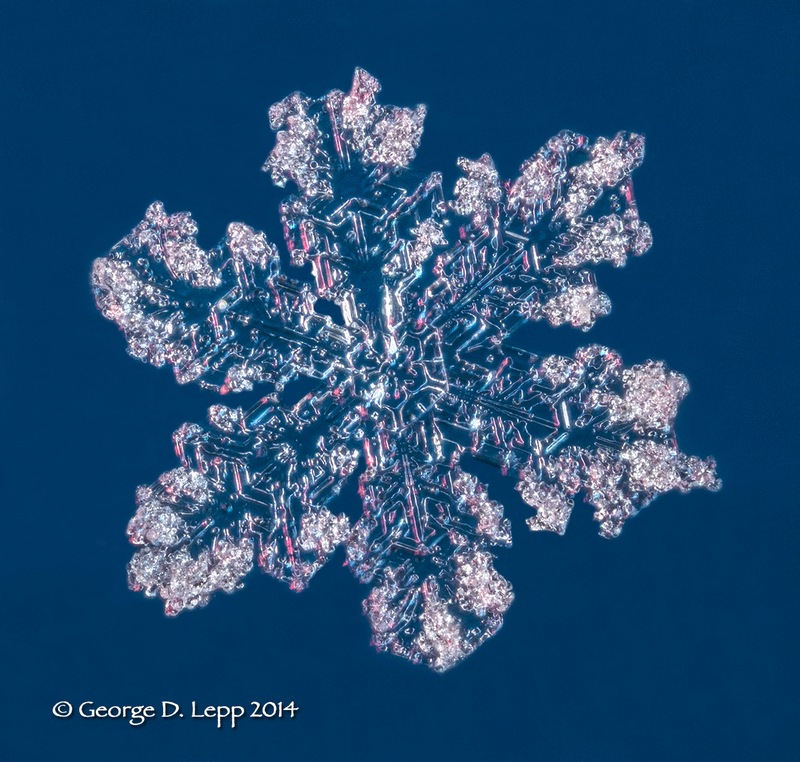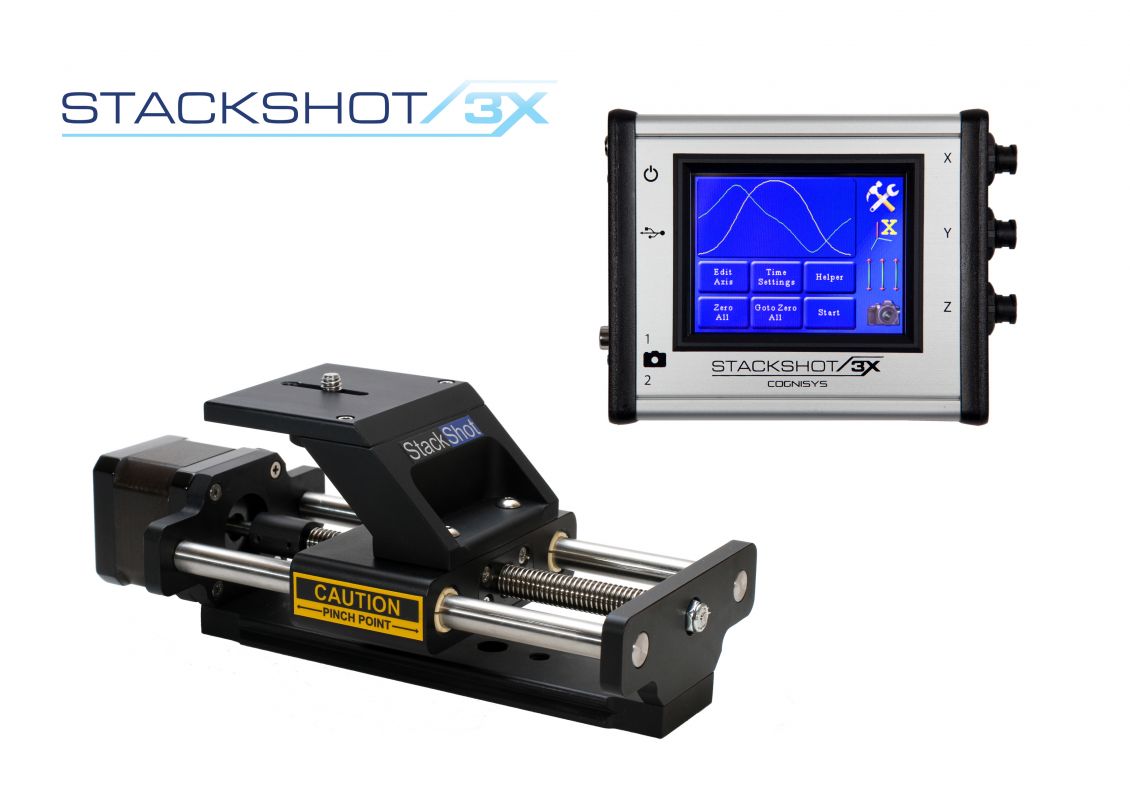Focus Stack Snowflakes with George Lepp
Stacking Snowflakes
This is an example of a nicely formed snowflake taken at around 6X with the system shown in the article. 6 images, 6X, f/5.6, ISO
Snowflakes are multi-dimensional, and photographing them at 4X to 8X in a single shot will not do them justice because you cannot get all of their facets in focus. I started photographing snowflakes in Colorado Springs about seven years ago after noticing the beautifully intricate crystals on my fleece jacket while I was shoveling their masses off the sidewalk. In the winter seasons since then, I’ve applied all the macro tools I could muster to get to 8X, and I’ve also learned how to identify a good snowflake subject and how to keep my hands warm.
Focus stacking is a critical component of capturing high magnification images of snowflakes sharp from facet to facet. Initially I used a microscope stage below the camera to position the snowflake through precision micro movements to do the stacking capture. Looking back at these images, it is evident that consistent movements are very difficult to accomplish manually, and I didn’t have enough stacks to achieve a consistently sharp composite. Lately, using the StackShot to manage the capture, and with more sessions under my parka, I’m finally getting the results that I had hoped for.

Snowflakes are multi-dimensional, and photographing them at 4X to 8X in a single shot will not do them justice because you cannot get all of their facets in focus. I started photographing snowflakes in Colorado Springs about seven years ago after noticing the beautifully intricate crystals on my fleece jacket while I was shoveling their masses off the sidewalk. In the winter seasons since then, I’ve applied all the macro tools I could muster to get to 8X, and I’ve also learned how to identify a good snowflake subject and how to keep my hands warm.
Focus stacking is a critical component of capturing high magnification images of snowflakes sharp from facet to facet. Initially I used a microscope stage below the camera to position the snowflake through precision micro movements to do the stacking capture. Looking back at these images, it is evident that consistent movements are very difficult to accomplish manually, and I didn’t have enough stacks to achieve a consistently sharp composite. Lately, using the StackShot to manage the capture, and with more sessions under my parka, I’m finally getting the results that I had hoped for.

Catching Flakes - Flakes are caught on a black card, such as this one, which has a soft flocked surface; if worthy of photography, a small brush is used to lift and transfer the flake to a cold glass slide and the photographic setup.
The Snowflake Studio - While photographing snowflakes requires studio technique, in this case my studio is anywhere that it’s freezing and the flakes are falling. My field set-up consists of a copy stand base to which I have attached a Really Right Stuff (RRS – www.reallyrightstuff.com) TP-243 ground-level tripod with a RRS BH-55 ballhead. The cameras used are either the Canon EOS 70D or Canon EOS 5D MK III. The lens used in all my snowflake photography is the Canon MP-E 65mm f/2.8 1X to 5X macro lens. With the 70D’s 1.6X crop factor the lens has a magnification of 8X--more than enough for even minute crystals.
My lighting from above is the Canon MT-24EX twin macro flash. The f/stop and ISO settings control exposure of these flashes. Positioned at a 45-degree angle below, I use either two Canon flashes (580EX) in wireless mode controlled by the MT-24EX on the camera and all set to manual, or lately, two small LED lights. The LED lights are actually small book or reading lights with clips (Mighty Bright HammerHead LED Music Book Light - $16 each from Amazon). Covering the lights with red and/or blue acetate available at hobby stores helps to define the complex structure of the crystals. By adjusting the camera exposure time these lights and the background light can be varied in intensity.
The set-up as described in the text with a Canon EOS 5D MK III, Canon MP-E 65mm Macro lens set to 5X, and Canon MT_24EX flash mounted to the front of the lens. All are attached to a Really Right Stuff ground-level tripod and BH55 ballhead. StackShot with controller, CamRanger attached to camera and sending to Apple iPad. LED photo light under a plastic cylinder and glass slide where the snowflake rests. Small LED book lights under snowflake for color accents.
The colored background beneath the snowflake is supplied by an LED photo light source (Neewer CN-160) that sells for $31 from Amazon. A colored acetate filter rests on diffusion material over the background light, which has a rheostat to control the light intensity. This serves as a base for a clear plastic cylinder that supports a glass slide—the snowflake’s final resting place.

StackShot Setup
The StackShot attaches to the camera/lens/flash setup and the tripod head as seen in the photo illustration below and physically moves the system through the desired range of focus. I use a CamRanger (www.camranger.com) wirelessly linked to an Apple iPad 3 to accurately view the subject, to position the snowflake, and to select the start and stop positions of the StackShot. In the field I’m always close to my vehicle, which has a power inverter to run the StackShot and anything else that might need recharging. I might add that all of the equipment needs to be maintained at the ambient temperature, and the best-formed snowflakes seem to be found in the coldest snowfalls.
The StackShot is usually set to a 40µm step and the 65mm lens should not be set to any f/stop higher than f/5.6 (f/4 is better to minimize diffraction). Experimentation viewed on the camera’s LCD and the iPad 3 will determine the shutter speed and ISO needed to balance the lighting.
For more inspiration, see the work of the CalTech physics professor, Ken Libbrecht. He is an expert in the science of snow, and his images are stunning. SnowCrystals.com
Now all you need are some well-defined snow crystals and way to keep your hands warm!
The Results



Thank you to George and Kathryn Lepp for the contribution of this page. You can see more of George's work on his web-page.


